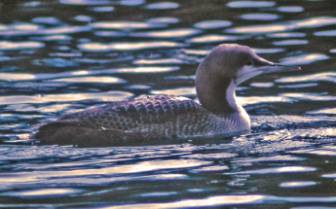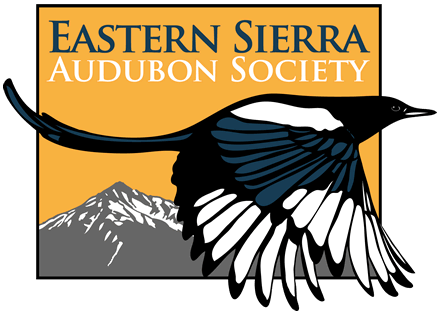[Originally appeared in the Sierra Wave newsletter, Vol. 27, No. 1, Sept-Oct 2008 – click here for original with photos]

Common Loon, Photo by Tom & Jo Heindel
There are three species of feathered loons that occur in Inyo County and untold numbers of the unfeathered kind. Most often recorded is the Common Loon, an uncommon spring and fall migrant and casual summer and winter visitor. Spring migrants are expected in early April and most have moved north by late May but lingerers have been found through early June. Usually 1 to 2 birds are seen, occasionally 3 to 4, but the spring maximum is 19 alternate-plumaged birds in a tight flock seen at Tinemaha Reservoir on 10 Apr 1975 on a rainy, early evening (T&J Heindel), behaving as though they had just arrived. Fall migrants begin to arrive in mid Sep but most move through from mid Oct to early Dec. Again, most sightings are 1 to 2 birds, but 3 to 4 are seen more often than in spring. The fall maximum is 16 birds in a flock at Haiwee Reservoir on a very windy day on 19 Nov 1996 (T&J Heindel). Windy days and days after strong winds provide the conditions whereby the birds drop into water bodies rather than fight the difficult conditions aloft. Winter birds average a sighting every other year, usually in January or February and there are three summer records, a pair at Tinemaha Reservoir 5 Aug 1989 (M.A. Patten), another pair at Tinemaha Reservoir 8 July 2003 (T&J Heindel) that responded to an imitated call by calling back, and a single bird at Second Lake, west of Big Pine 15 Jul 2008 (D. Holway), which set a county high elevation record!

Pacific Loon, Photo by Tom & Jo Heindel
The next most numerous loon is the Pacific Loon, a rare fall migrant recorded almost fifty times, with the vast majority of records from the Owens Valley where there are many more reservoirs, lakes, and ponds. Most birds move south from early Oct to early Dec although there is an avant garde in late Sep and a tail-end Charlie in mid Dec. Almost all sightings are of single birds but there are several records of two birds and the maximum is three seen at Tinemaha Reservoir 5 Nov 2001 (J.L. Dunn). There are two spring records, both in May (J.L. Dunn; M. Brady, S. Glover, M. Prather). This lopsided seasonal distribution is the result of most of the arctic breeders heading west to the coast and then south to their wintering areas along the Pacific Coast to Mexico. But some birds head south and then move west to the coast leaving a sprinkling of records scattered over most of the western states to mark their passage. It is not known why there are so few spring records in the county but it could be because the birds remain along the coast and move north before turning east or they may head east from the coast and overfly the county completely.
The Red-throated Loon has been recorded eleven times in the county, all single birds and almost all seen in Nov. The earliest arrival is 9 Oct which corresponds with the rest of the state but it is an outlier in the Eastern Sierra and the eastern desert of Kern County. The latest record is 28 Dec 2002 (T&J Heindel) excluding a bird that arrived at Diaz Lake 21 Dec 1992 that was last seen 10 Jan 1993 (J.L. Wickman). All county records are since 1990 and likely reflect the increased birding coverage since then rather than a change in the distribution of this species.
A loon to be looked for is the Yellow-billed Loon, which has been recorded in Mono County 8 Dec 1976 (D. Gaines) and reported in late February 1976 at Tinemaha Reservoir (T&J Heindel), although not adequately documented to be included as a county record. A pattern of interior records indicates a window from mid Oct to early May with most records occurring Dec to Feb.
Field guides adequately depict the plumage differences between loons with basic plumage being the most similar looking between the species but each has distinct characteristics that clinch the identification. Bill size, shape and color, neck pattern, and floating posture will usually make a well-seen loon an easy call. Once you become proficient in loon identification you just may become a loon lover, also known as a loonie!
Tags: loon



